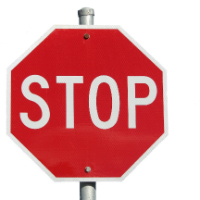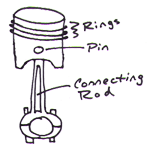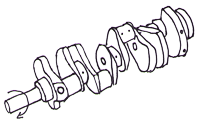 WAIT, BEFORE YOU SCROLL DOWN! While I know a lot about cars, I don't know a lot about YOUR CAR! A repair manual is essential and I have a way for you to get one FREE.
WAIT, BEFORE YOU SCROLL DOWN! While I know a lot about cars, I don't know a lot about YOUR CAR! A repair manual is essential and I have a way for you to get one FREE. Click Here To Read More(Link opens in a new window)
On The Road
Weird noises coming from your engine?
First, check the oil level. Higher pitched noises and ticking tend to be valvetrain issues. Lower pitched knocking tend to be bearings. Do not attempt to drive your car if the oil light is on, temperature gauge is in the red zone or smoke is coming from the engine compartment or tailpipe.
Check Engine Light On?
The check engine light can be on for many reasons. If the engine seems to be running ok, take the light as a strong suggestion to get the codes scanned and repairs done ASAP. You can still drive the vehicle short distances and most times the check engine light is related to emissions control equipment. (fuel cap, EGR, etc)
Want to be more prepared for roadside emergencies?
Video Clips
The Automotive Engine
How your car engine works...
Today's engine is a collection of advanced parts and systems that provide the driving force to get you down the road. Modern electronics and materials may have made repairing engines more complicated, but the basic engine layout has not really changed over the years. Proper care and feeding of your engine will have it purring for many years. The best way to start learning about how your engine works, is to break down the engine in to parts, and explore each parts function.
Pistons:
 Most common engines have 4, 6, or 8 pistons which move up and down in the cylinders. On the upper side of the piston is what is called the combustion chamber where the fuel and air mix before ignited. On the other side is the crankcase which is full of oil. Pistons have rings which serve to keep the oil out of the combustion chamber and the fuel and air out of the oil. Pistons are made from lightweight aluminum alloy and are designed to float in the cylinder without contacting the cylinder walls. They float on a thin layer of oil which is below the rings. If the rings fail, oil can leak into the combustion chamber and you will see grey smoke coming from the exhaust. If the rings wear or you lose oil to the engine, the pistons can score the cylinder walls damaging the engine and requiring a rebuild.
Most common engines have 4, 6, or 8 pistons which move up and down in the cylinders. On the upper side of the piston is what is called the combustion chamber where the fuel and air mix before ignited. On the other side is the crankcase which is full of oil. Pistons have rings which serve to keep the oil out of the combustion chamber and the fuel and air out of the oil. Pistons are made from lightweight aluminum alloy and are designed to float in the cylinder without contacting the cylinder walls. They float on a thin layer of oil which is below the rings. If the rings fail, oil can leak into the combustion chamber and you will see grey smoke coming from the exhaust. If the rings wear or you lose oil to the engine, the pistons can score the cylinder walls damaging the engine and requiring a rebuild.

Crankshaft:
The crankshaft is connected to the pistons via a connecting rod. As the piston moves up and down in the cylinder it rotates the crankshaft and converts the straight line motion into rotary motion.Valvetrain:
The valvetrain consists of valves, rocker arms, pushrods, lifters, and the cam shaft. The valvetrain's only job is that of a traffic cop. It lets air and fuel in and out of the engine at the proper time. The timing is controlled by the camshaft which is synchronized to the crankshaft by a chain or belt.Now that we have a general overview of the parts involved let's talk about what happens during the normal operation of your engine. Most automotive engine today are 4-stroke (or 4-cycle) engines, meaning they have four distinct events which make up the cycle. A 4-stroke engine takes two complete crankshaft revolutions to complete the cycle. Below are the 4 complete parts of the 4-stroke cycle...
* Intake stroke:
The camshaft opens the intake valve and the piston moves down the cylinder. This creates vacuum and sucks in air and fuel into the combustion chamber above the piston.* Compression stroke:
As the piston starts moving back up the cylinder the intake valve closes and seals off the combustion chamber. The causes the air and fuel to compress.* Power stroke:
As the fuel is compressed and the piston nears the top of the cylinder the spark plug fires and ignites the fuel and air. This explosion pushes the piston back down the cylinder and drives the crankshaft.* Exhaust stroke:
After the piston reaches the bottom of the cylinder, the exhaust valve opens and the gasses left over from the fuel and air are sent out to the exhaust system.To get a more indepth look into the engine, take a look at the Road Machines CD free preview.
Put these four events together in the above order and you have a complete cycle. Are you asleep yet? That's enough theory, let's talk about the real world and problems you might encounter with the above mentioned parts.
Pistons:
Remember I talked about the rings which seal the combustion chamber from the crankcase. The rings over time tend to wear out. When they wear they allow the fuel and air to enter into the oil and dilute it. This dilution reduces the oils ability to lubricate your engine and can cause premature wear. Also if the rings wear down they can allow oil from the crankcase to enter the combustion chambers. This will result in oil being burned and exiting your tailpipe as grayish/white smoke. If your car spews grayish white smoke and it does not go stop in the first few minutes after start-up you might have warn rings. If the smoke goes away after start-up look to the valvetrain section.Crankshaft:
The crankshaft rides on bearings which can wear down over time. The bearings support the crankshaft and also the rods which connect the pistons to the crankshaft. A loud medium pitched knocking noise in the engine points to warn bearings most of the time. This is usually a costly repair and involves removing the crankshaft and either machining the surface where the bearings ride, or replacing the entire crankshaft. To prevent this type of problem, use a high quality oil, change your oil at suggested intervals (3 months or 3000 miles is a safe number) and always maintain your oil level between oil changes. Many times it is more economical to buy a replacement engine, than to have your engine rebuilt when you have a crankshaft bearing failure. Your mechanic can give you a better idea of costs involved.Valvetrain:
Remember the oil smoke problem mentioned above in the piston sections. If your car only smokes grayish/white smoke at start-up you may have leaking valve seals. Valve seals keep oil from above the valve from leaking into the combustion chamber. When they wear, they can allow oil to seep into the combustion chamber and collect there until your start the engine again. You generally do not get oil leaking past the valve seals while the engine is running since the seals expand with the heat of the engine and plug the leak.Another common problem is the timing chain or belt will slip or even break causing the camshaft to stop rotating. Remember the camshaft tells the valves when to open and if it stops spinning then the valves stop opening and closing. No valve moving, no engine running :-)
A term you will here when talking about timing chains and belts is "interference engine". When an engine is an "interference engine" the pistons and valves are so close together that if the valves were to stop moving (broken belt or chain) and the crankshaft kept spinning they would crash into the piston. (that's the interference) This crash tends to do bad things to an engine, breaking valve, bending pushrods, and even cracking pistons. This is why most manufacturers recommend changing the timing chain or belt every 60,000 miles. Timing belts dry out, stretch and deteriorate over time so even if you do not have 60,000 miles on the car think about changing the belt after it's 6 years old. If you are wondering if your engine is an interference engine, you can check with Gates, who makes timing belts and has a PDF file which will tell you if your engine is an interference engine and the recommended service interval.
Preventive Maintenance:
* Change your oil regularly and use the recommend weight of oil. Check your owners manual or under the hood for the correct oil to be used.
* Give your engine a chance to warm up before driving if possible. Doing this will let the oil get into all parts of the engine before you put a load on the engine. This is even more critical in cooler temperatures when the oil is cold and sluggish.
* Change your timing belt or chain at your manufacturer's recommended interval.
* Avoid "snake oil" additives advertised on late night TV. Regular oil changes and good maintenance habits will keep your engine running it's best.
* If you have a turbo-charged engine, give the engine a minute or two to cool down before turning it off. This cool down period allows oil to circulate and cool down the bearings in the turbo. If you shut off the engine immediately after hard driving, the oil can gum up around the hot bearings and create problems down the road.
*If you have to replace your engine, discuss the benefits of buying used versus new. If you plan on keeping your car for some time, a new engine might be the best bet. Sometimes new engines are not much more expensive than rebuilt ones, and offer the best solution.
*When trying to diagnose engine noises, be as descriptive as possible. Take note to when the noise occurs, at what throttle position, and when the noise started occurring. Sometimes changing the weight of oil being used can cause a new noise to crop up. Make sure your mechanic knows if you changed oil brands or weight recently.